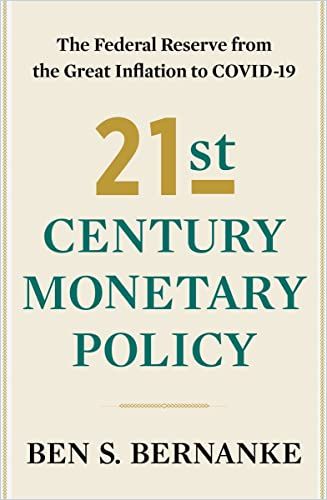Former Federal Reserve chair Ben S. Bernanke offers a clear, comprehensive overview of US monetary policy.

Understanding Monetary Policy
Former Federal Reserve chair Ben S. Bernanke — who also wrote the bestselling The Courage to Act — skillfully communicates the complex details of monetary policy and its recent history.
The Federal Reserve
Two theoretical values frame monetary policy decisions. First, the “natural rate of unemployment” is a jobless level that economists believe is the minimum or ideal rate at which an economy can function. Aiming for unemployment below this rate through monetary stimulus proves unsustainable. Stimulus would cause inflation, because aggregate demand would exceed supply capacity. The “neutral rate of interest” is the rate that economists believe will theoretically neither expand nor contract the economy.
Home builders mailed pieces of two-by-fours to the Fed inked with messages imploring the chair [Paul Volcker] for relief. Some of these missives still decorated my office when I was chair. Ben S. Bernanke
Monetary and fiscal policy can affect the unemployment rate in the short term, but the long-term theoretical natural rate depends on demographics, workforce skills, business needs, automation, and the efficiency of the labor market in matching people with jobs.
The standard response of central banks to a recession has been to reduce interest rates to encourage investment and borrowing. But after 2008, already low interest rates left central bankers with little corrective ammunition. So the Fed stepped up quantitative easing (QE).
QE occurs when a central bank buys safe assets, such as government bonds and government-sponsored mortgage-backed securities. The central bank thus injects money into the financial system while buying safe investments. As do lower interest rates, QE makes investment borrowing cheaper. QE functions as a “signaling channel” that a central bank has the capability to make borrowing as easy as it thinks is best for the economy for as long as it wants.
Forward Guidance
Due to Bernanke’s insistence on transparency and communication, the Fed produces signaling information, such as the voting records of the Federal Open Market Committee (FOMC) and charts that reveal members’ estimates of unemployment, growth, and inflation.
Specific forward guidance has become a tool, along with QE, to ease financial conditions, particularly when lowering interest rates proves less effective at that easement. A central bank that commits to specific targets — for example, unemployment falling below 5% — convinces financial markets that long-term as well as short-term assets should have low interest rates.
The COVID-19 pandemic led the central bank to employ an expanded arsenal of QE and forward guidance.
The Fed’s varied and sweeping actions during the pandemic, and the speed at which they were decided upon and announced, once would have seemed inconceivable.Ben S. Bernanke
The scale of the pandemic caused a seizing up of markets, with only the Fed’s powerful, comprehensive role as the lender of last resort preventing financial chaos. For example, the Fed backstopped corporate bond and municipal bond markets, and provided liquidity in US dollars to foreign markets. Merely the announcement that the Fed was about to intervene in a market often stabilized prices.
Regulation
Some think that the Fed could have done more to prevent the housing bubble that burst in 2008. But would raising interest rates by a few percentage points have held back a pre-2008 property boom? Inflation-adjusted mortgage rates were around 4% to 5%, which is not that low a rate. The relevant issues had more to do with the then-new, opaque securitized financing practices that reduced the incentives for careful lending, along with a vague political desire to encourage home ownership.
Monetary policy is a blunt tool: Changes in interest rates affect the entire economy and cannot target a narrow set of markets or a few overheated sectors.
Critics worry that QE, because it creates new money while keeping returns low, motivates a reckless “reach for yield.” But Japan has had easy monetary conditions for decades and doesn’t have issues with risk taking. This suggests that the US financial sector’s culture is a crucial factor. In the 19th century, prior to the Fed’s existence, daring financial risk taking, manias, and panics abounded. This suggests that the current destabilizing behavior did not spring entirely from Fed stimulus.
Targeted regulation can prevent financial crises. The financial crisis triggered by the COVID-19 pandemic revealed that legislation — such as the Dodd-Frank Act, with its stress testing and living wills regime, and other new safeguards, including the Fed’s Office of Financial Stability — had prepared banks for a crisis. The Fed backstopped markets experiencing runs and fire sales, but Bernanke insists that before-the-fact regulation would have proven more effective.
The tax system, through higher capital gains and inheritance taxes, can tackle the side effect of accelerating inequality. Prioritizing employment and the years-long trend of low inflation encouraged the Fed to abandon notions of preemptive strikes on inflation.
Independence and Integrity
Those who disagree with the Fed’s stimulative policies have to consider an alternative past, in which the American economy had higher unemployment and possibly a deflationary spiral after 2008. Because the US political system limits tax-and-spend policies, had the Fed not used monetary stimulus, the ensuing recession would have been catastrophic.
The United States’ strong populist tradition is hostile to concentrated power. This — alongside the internet-fueled trend for conspiracy theories and fractured politics — endangers the Fed’s independence. The political right criticizes the Fed for creating new money; the left harangues it for bailing out banks.
Partisan policy makers, facing regular elections and swings in political sentiment, would find it difficult, if not impossible, to make credible promises about policies three or four years in the future, nor do partisan policy makers have much incentive to follow through on commitments made by political opponents.Ben S. Bernanke
Bernanke strongly resists Congress’s “Audit the Fed” proposals that seek to micromanage the central bank. He recognizes, however, that America’s short-term electoral cycles will inevitably erode the all-important credibility of the Fed and monetary policy.
Memoir/Policy Guide
Ben S. Bernanke reveals his talent for communicating the complex details of monetary policy and its recent history. He predictably defends the Fed’s actions, especially the quantitative easing and forward guidance that Bernanke deployed during the 2008 financial crisis. He acknowledges the challenges central bankers face and their determination to remain evidence-focused and adaptable. You may disagree with certain decisions Bernanke made during his tenure, but his memoir/policy guide will likely convince you that he always did what he thought was best to steer the nation’s financial system through turbulent times.











